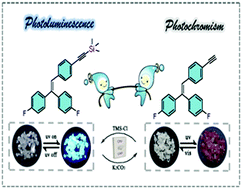Switching excitons between the emissive and photochromic pathways in the triphenylethylene system†
Abstract
Photoluminescence and photochromic pathways are competitive during the exciton-decay processes. To rationally control molecular photoluminescence and photochromic properties, triarylethylene derivatives combining ethynyl and ethynyltrimethylsilane groups, namely TrPEF2![[triple bond, length as m-dash]](https://www.rsc.org/images/entities/char_e002.gif) H and TrPEF2
H and TrPEF2![[triple bond, length as m-dash]](https://www.rsc.org/images/entities/char_e002.gif) TMS, were designed and synthesized in this work. By simply attaching and removing the TMS protecting group, these two molecules can be mutually converted. Detailed photophysical and photochromic investigations revealed that molecules TrPEF2
TMS, were designed and synthesized in this work. By simply attaching and removing the TMS protecting group, these two molecules can be mutually converted. Detailed photophysical and photochromic investigations revealed that molecules TrPEF2![[triple bond, length as m-dash]](https://www.rsc.org/images/entities/char_e002.gif) H and TrPEF2
H and TrPEF2![[triple bond, length as m-dash]](https://www.rsc.org/images/entities/char_e002.gif) TMS exhibit distinct emissive and photochromic behaviors in the crystalline state: TrPEF2
TMS exhibit distinct emissive and photochromic behaviors in the crystalline state: TrPEF2![[triple bond, length as m-dash]](https://www.rsc.org/images/entities/char_e002.gif) H features a pronounced photochromic property and a low photoluminescence quantum yield (PLQY) of 1.5%, whereas a weak photochromic response and a high PLQY of 14.2% were obtained in crystalline TrPEF2
H features a pronounced photochromic property and a low photoluminescence quantum yield (PLQY) of 1.5%, whereas a weak photochromic response and a high PLQY of 14.2% were obtained in crystalline TrPEF2![[triple bond, length as m-dash]](https://www.rsc.org/images/entities/char_e002.gif) TMS. The distinguished difference is proposed as due to the introduction of the bulky trimethylsilane moiety in TrPEF2
TMS. The distinguished difference is proposed as due to the introduction of the bulky trimethylsilane moiety in TrPEF2![[triple bond, length as m-dash]](https://www.rsc.org/images/entities/char_e002.gif) TMS, which effectively suppressed the molecular vibrations and photocyclization reactions. Single crystal analyses and theoretical calculations were further carried out to interpret the distinction of the photophysical and photochromic properties in molecules TrPEF2
TMS, which effectively suppressed the molecular vibrations and photocyclization reactions. Single crystal analyses and theoretical calculations were further carried out to interpret the distinction of the photophysical and photochromic properties in molecules TrPEF2![[triple bond, length as m-dash]](https://www.rsc.org/images/entities/char_e002.gif) H and TrPEF2
H and TrPEF2![[triple bond, length as m-dash]](https://www.rsc.org/images/entities/char_e002.gif) TMS. Furthermore, TrPEF2
TMS. Furthermore, TrPEF2![[triple bond, length as m-dash]](https://www.rsc.org/images/entities/char_e002.gif) H and TrPEF2
H and TrPEF2![[triple bond, length as m-dash]](https://www.rsc.org/images/entities/char_e002.gif) TMS were applied in a photo-controlled pattern showing reversible on–off switching emission. This design strategy gives the two molecules incomparable advantages in dual-mode signal and surface-involved photoresponsive applications, such as data encryption and information storage.
TMS were applied in a photo-controlled pattern showing reversible on–off switching emission. This design strategy gives the two molecules incomparable advantages in dual-mode signal and surface-involved photoresponsive applications, such as data encryption and information storage.



 Please wait while we load your content...
Please wait while we load your content...